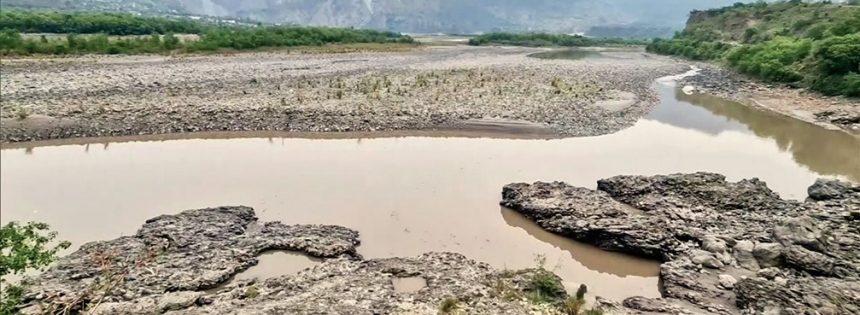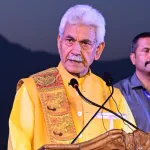Srinagar/Jammu, May 05: In an unprecedented event, the mighty Chenab River in Jammu’s Akhnoor area went almost completely dry on Monday, exposing the riverbed for the first time in recorded history. The sudden drop in water level followed the closure of gates at the Baglihar and Salal dams by the Government of India—a move many interpreted as a strategic response to recent tensions with Pakistan.
Videos and eyewitness accounts from Akhnoor showed stunned locals walking across what was once a fast-flowing river, with the water reduced to ankle height. For some residents, it was a surreal and emotional moment.
“I’ve lived here for over 40 years, and I’ve never seen anything like this,” said Rajat Sharma, a local schoolteacher. “People were walking across the Chenab. It felt historic—both shocking and fascinating.”
Ravi Gupta, Bhagwan Singh Jamwal, and Ritu Sharma, residents of Akhnoor, echoed similar disbelief. “We have grown up next to this river. Seeing its bed exposed felt unreal. People even started looking for gold and silver,” said Gupta.
The Chenab, which flows directly into Pakistan from Akhnoor, is considered vital not only to the region’s ecology but also geopolitically. The water level dropped so low that even the Ranbir Canal, which draws from the Chenab and is considered the lifeline of Jammu’s agriculture, ran almost dry by Monday morning.
The sudden disappearance of water drew hundreds of curious onlookers to Akhnoor. But the situation quickly turned dangerous. Loudspeaker announcements by Jammu and Kashmir Police warned people to vacate the riverbed.
“There has been rainfall upstream, and a sudden surge in flow is expected. Please evacuate immediately for your safety,” police warned.
By Monday afternoon, just 18 to 20 hours after the gates had been shut, authorities began releasing water back into the river. Water levels rose rapidly, and by 1:30 PM, the Chenab had returned to near-normal levels. The Ranbir Canal also resumed its flow by 7:45 PM, restoring irrigation to key agricultural zones in RS Pura and other parts of Jammu.
“We’re relieved that people moved in time. The river can turn deadly in minutes,” said the Station House Officer (SHO) of Akhnoor, who oversaw the evacuation.
Many residents and political observers interpreted the unprecedented action as a strong message to Pakistan following the April 22 terror attack in Pahalgam, which claimed 26 civilian lives, most of them tourists. In response, the Centre suspended the 1960 Indus Waters Treaty (IWT). “This is the strongest answer we could have given,” said Kalyan Singh, a retired Army officer from Akhnoor. “For years, we’ve suffered attacks. If Pakistan won’t stop terror, why should we send them our water?”
Another resident, 75-year-old Pandit Mohan Lal, said, “In my lifetime, I’ve never seen Chenab like this. But I support the government. Our safety must come first.”
While water has been restored, local officials remain vigilant due to unpredictable upstream weather. Disaster response teams and police have been directed to monitor riverbanks for any sudden surges in flow.
Authorities have also appealed to the public to refrain from treating the riverbed as a curiosity or gathering point. “This is not a playground. Rivers can change in minutes,” said the SHO.
Akhnoor wakes to a ‘silent Chenab’ for the first time
• Water flow in Chenab river restored in 20 hours • Baglihar & Salal Dam closure causes historic water depletion in Chenab River • Residents call it symbolic answer to Pak after Pahalgam terror attack

Leave a Comment Leave a Comment







